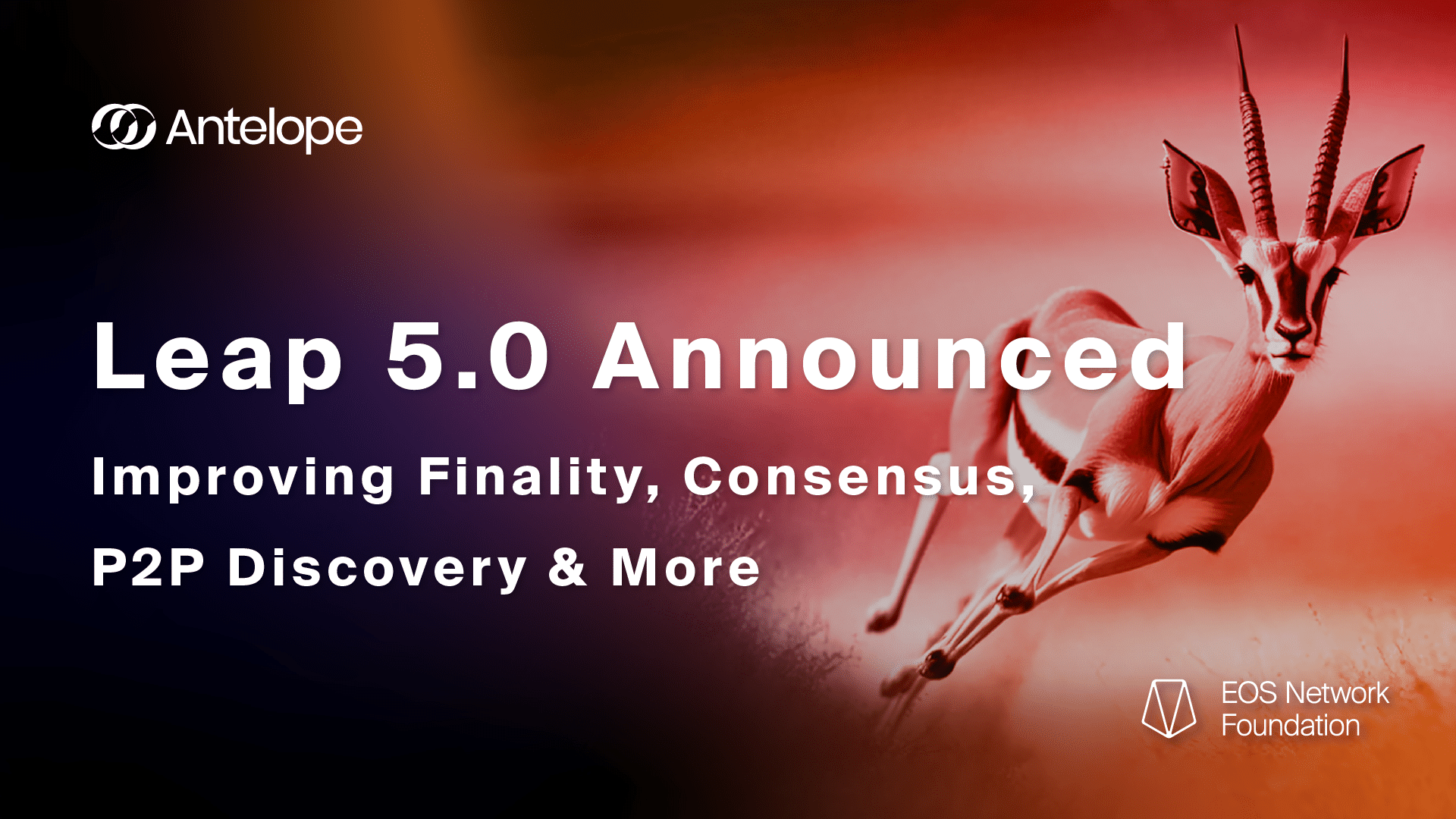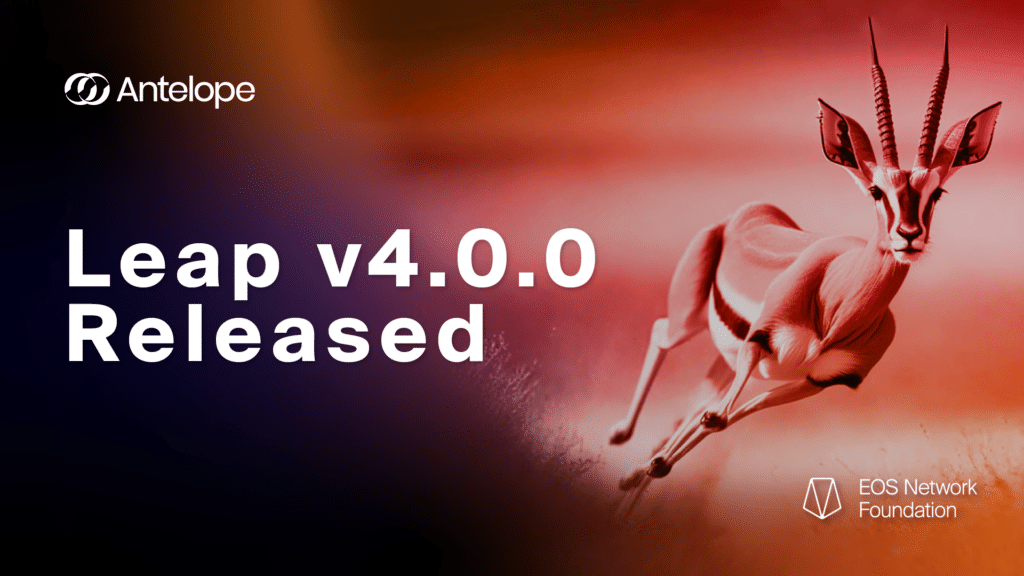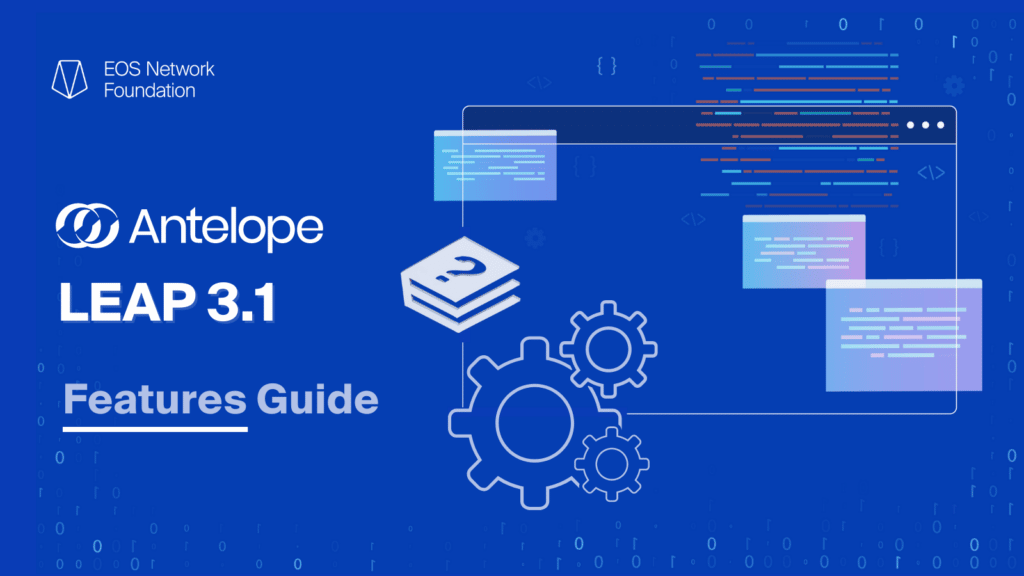Note: Key technical features referred to in this article, such as instant finality and cryptographic primitives, initially slated for Leap 5, are now scheduled to be delivered with the Leap 6 hard fork in the latter half of 2024.
As such, Leap 5 is no longer a mandatory consensus upgrade (hard fork).
Please see “Leap 5’s Promise, Pursuit of Excellence“, for additional details.
The EOS Network Foundation (ENF) is excited to announce that a major consensus upgrade, Antelope Leap 5.0, is slated for launch in Q4 2023. This landmark consensus upgrade (hard fork), the second significant upgrade in less than eighteen months, showcases the flexibility of EOS and the dedication of its community in coordinating a cycle of continuous improvements to the underlying protocol.
Antelope Leap 5.0 is expected to introduce an array of innovative features that will redefine the network’s capabilities and further distinguish EOS from other premier Layer 1 protocols.
Key introductions with the upgrade will include: Instant Finality, Integration of the HotStuff consensus algorithm, and peer-to-peer protocol enhancements. These upgrades open up a whole new set of features for EOS and other Antelope based chains. For instance, new cryptography intrinsics enable developers to write smart contracts that efficiently verify zero knowledge proofs, while new opportunities for alternative consensus mechanisms also emerge.
Key Technical Features of Leap 5.0
Leap 5 will usher in major technical innovations to greatly enhance the network’s capabilities.
Instant Finality: To provide a Web3 experience that feels like Web2, time to finality is crucial. One of the building blocks for this is the introduction of aggregate BLS signatures to support the HotStuff consensus algorithm where multiple signatures and multiple public keys can be combined into a single signature and verified as a single operation. This enables dramatic improvements in scalability and time to finality, with most transactions reaching finality in a few seconds. This makes the network vastly more efficient and allows for dApps to approach a user experience on par with Web2 applications. Antelope Trustless IBC also benefits from Instant Finality, with finality between blockchains also being reduced to just a few seconds. These Instant Finality improvements will also extend to the EOS EVM.
HotStuff Consensus Algorithm: An open source technology originally developed by VMware in 2018, later selected for use by the Facebook Libra initiative. HotStuff greatly enhances the capabilities available on EOS and all Antelope chains.
The introduction of aggregate BLS signatures in HotStuff presents an additional opportunity to derive more abstract cryptographic building blocks from which to construct additional ZK proof systems, and to implement these cryptographic primitives into the native tooling on Antelope. This has opened the door for previously unavailable features such as confidential transactions, and additional privacy mechanisms such as using private addresses in place of accounts. With these features, EOS, and all Antelope based blockchains will have an industry leading implementation of crypto primitives, able to verify ZK proofs at a lightning fast 1.1ms*, which opens up massive opportunities for all Antelope chains. The availability of these new crypto primitives can have a profound impact on financial system integrity, facilitating free and open markets and allowing for private transactions. With Leap 5.0, Antelope chains will have native ZK proof enabled smart contracts at their core.
*As benchmarked with an I9-13900 CPU.
Peer-to-peer Protocol Improvements: In coordination with the Antelope Coalition, a team from the University of Fudan has been working on improvements to the peer node discovery and synchronization process within the peer-to-peer (P2P) protocol of the nodeos service.
Moving Beyond DPoS: Leap 5 Opens New Possibilities
Leap 5.0 is not just a technical milestone, but rather, it marks a significant coming of age for the EOS community. During the last major consensus upgrade, dubbed EOS Independence Day, the network transitioned from EOSIO to Antelope. The upcoming upgrade to Leap 5.0 offers the network an opportunity to replace DPoS with an alternative consensus mechanism, which would be a monumental shift from the original EOS Network vision to a truly community-led endeavor.
The responsibilities of Block Producer within the current consensus mechanism can now be broken down into three separate roles:
- Block Proposer: A Block Proposer organizes transactions into a proposed block.
- Consensus Leader: A Consensus Leader coordinates Block Finalizers to generate Quorum Certificates that prove a proposed block is final.
- Block Finalizer: Block Finalizers send signatures on block proposals to the Consensus Leader to aggregate into Quorum Certificates.
In Leap 5.0, Block Producers will fulfill all three roles, however the new consensus algorithm provides the foundation to decouple these roles into separate entities in the future. For example, the network could choose to constrain costs by continuing to limit Block Proposers to a moderate number of high-performance nodes while simultaneously improving network security and decentralization through a significant increase in the number of Block Finalizers.
Further details around these new possibilities will be explored in the coming months. To learn more now, listen to this clip with Guillaume Babin-Tremblay of UX Network from the EOS Fireside Chat.
Words of Acknowledgment
Preparing these new features for implementation in Antelope Leap 5.0 is a serious and multidisciplinary undertaking which has involved the writing of a new low-level cryptography implementation, the bls12-381 library, developed by Matthias Schoenebeck of ZEOS, which was reviewed for issues and potential optimizations by experienced cryptographer and ENF Senior Engineer, Yarkin Who, PhD. Meanwhile, considering the specifics of adding host functions to the blockchain, and implementing strategies for long-term library maintainability and improvability without causing consensus failures has been the purview of consensus level engineers, ENF Director of Engineering, Areg Hayrapetian, and ENF Principal Engineer, Matt Witherspoon. Leading the efforts for implementation of the HotStuff Consensus Algorithm and Instant Finality is Guillaume Babin-Tremblay of UX Network, with support from ENF’s Areg Hayrapetian. More engineers than can be mentioned here, from within the ENF and the wider Antelope Ecosystem, have all contributed, and continue to contribute in many ways to the evolution towards Leap 5.0. To all of you, we extend our sincere gratitude and appreciation.
Notice to Infrastructure Providers, Technical Partners, & Antelope Ecosystems
As we prepare for this significant milestone, cooperation from all ecosystem contributors is vital.
The last upgrade of this size was the launch of Antelope Leap 3.1. Similar to the launch of Leap 3.1, this upgrade will involve a coordinated effort from contributors across the ecosystem.
All infrastructure providers should mark their calendars for the upgrade, tentatively scheduled between late November and early December 2023.
**Anyone running a node must upgrade their nodes before the date (TBD) of the consensus upgrade to continue syncing with the network.
More precise timelines will follow, please stay abreast of developments as we approach the consensus upgrade.
Stay updated with all future announcements by following the EOS Network Foundation on Twitter and subscribe to the ENF YouTube channel for informative weekly Node Operator Roundtable discussions.
Additional content including deep dives, videos and technical documentation will continue to be released over the next few months as we prepare for the consensus upgrade to Leap 5.0!
The forthcoming upgrade to Antelope Leap 5.0 represents a profound milestone in the EOS community’s journey. Not only does this upgrade introduce ground-breaking new features, but it also advances the community-led nature and independence of EOS. Such consensus upgrades, often challenging in other Web3 ecosystems, are feasible in EOS thanks to a strong technical foundation and the cooperation and coordination between EOS Network participants and the broader Antelope Coalition.
EOS Network
The EOS Network is a 3rd generation blockchain platform powered by the EOS VM, a low-latency, highly performant, and extensible WebAssembly engine for deterministic execution of near feeless transactions; purpose-built for enabling optimal Web3 user and developer experiences. EOS is the flagship blockchain and financial center of the Antelope framework, serving as the driving force behind multi-chain collaboration and public goods funding for tools and infrastructure through the EOS Network Foundation (ENF).
EOS EVM
The EOS EVM is an emulation of the Ethereum EVM, housed within an EOS smart contract. It offers feature parity to other EVMs in the space but with unmatched speed, performance and compatibility. EOS EVM connects the EOS ecosystem to the Ethereum ecosystem by allowing developers to deploy a wide array of Solidity-based digital assets and innovative dApps on EOS. Developers can use EOS EVM to take advantage of Ethereum’s battle-tested open source code, tooling, libraries and SDKs, while leveraging the superior performance of EOS.
EOS Network Foundation
The EOS Network Foundation (ENF) was forged through a vision for a prosperous and decentralized future. Through our key stakeholder engagement, community programs, ecosystem funding, and support of an open technology ecosystem, the ENF is transforming Web3. Founded in 2021, the ENF is the hub for EOS Network, a leading open source platform with a suite of stable frameworks, tools, and libraries for blockchain deployments. Together, we are bringing innovations that our community builds and are committed to a stronger future for all.



